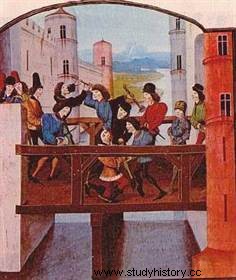 In the heart of the Hundred Years War, a real civil war opposes the Armagnacs , loyal to the royal family, and the Burgundians who allied themselves with the English. Since 1389, King Charles VI has regularly suffered from fits of dementia. A regency council was exercised by his brothers, of whom Louis was the most influential at the beginning of the 15th century, despite the growing power of the house of Burgundy. This rivalry will reach its climax with the assassination of Louis, Duke of Orléans, on the orders of Jean sans Peur, Duke of Burgundy, on November 23, 1407.
In the heart of the Hundred Years War, a real civil war opposes the Armagnacs , loyal to the royal family, and the Burgundians who allied themselves with the English. Since 1389, King Charles VI has regularly suffered from fits of dementia. A regency council was exercised by his brothers, of whom Louis was the most influential at the beginning of the 15th century, despite the growing power of the house of Burgundy. This rivalry will reach its climax with the assassination of Louis, Duke of Orléans, on the orders of Jean sans Peur, Duke of Burgundy, on November 23, 1407.
Charles VI and the Great
King Charles VI succeeded his father Charles V in 1380. The latter had significant success against the English, and he strengthened the royal power. However, his successor could not really take advantage of the situation:on his arrival on the throne he was young and power was exercised by Jean de Berry and Philippe le Hardi, Duke of Burgundy. But the other Greats of the kingdom, including the Duke of Anjou, are demanding their share.
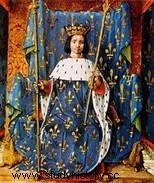 France then experienced a period of unrest and revolts. However, the king won at the Battle of Roosebecke on November 27, 1382, in Flanders, and gradually managed to impose his authority. In 1388, he freed himself from the influence of his uncles, and surrounded himself with advisers called the Marmousets; the royal power is strengthened again. Unfortunately for Charles VI, he was seized with madness on August 5, 1392:his illness annihilated his power, and he fell again under the control of more rival dukes than ever...
France then experienced a period of unrest and revolts. However, the king won at the Battle of Roosebecke on November 27, 1382, in Flanders, and gradually managed to impose his authority. In 1388, he freed himself from the influence of his uncles, and surrounded himself with advisers called the Marmousets; the royal power is strengthened again. Unfortunately for Charles VI, he was seized with madness on August 5, 1392:his illness annihilated his power, and he fell again under the control of more rival dukes than ever...
The rivalry between Armagnacs and Burgundy
Charles VI's madness brings Philip the Bold back to government, which he soon fully controls. The Duke of Burgundy then took the opportunity to negotiate truces with an England also divided after the struggles between Richard II and Henry of Lancaster. He also contracts alliances with Austria, Bavaria and Luxembourg. Finally, he finances a crusade led by his son Jean to help the Hungarians threatened by the Ottomans in the Balkans. It is a failure following the disaster of Nicopolis in September 1396, Jean is taken prisoner. From the years 1400-1402, the Duke of Burgundy found himself facing a new rival, Louis, Duke of Orléans and brother of the king. The tension continues to mount, without however reaching great violence, with the exception of a few scuffles.
The situation changed with the coming to power in Burgundy of the son of Philippe le Hardi, Jean sans Peur. The latter, freed from Turkish jails in 1398, succeeded his father in 1404. The following year, he inherited from his mother the counties of Flanders and Artois. Jean certainly pays homage to Charles VI, but he quickly opposes Louis d'Orléans, who succeeded Philippe le Hardi to the mad king. Reduced to his principality, cut off from his trade with the English, Jean sans Peur decides to solve the problem by violence.
November 23, 1407:the assassination of the Duke of Orléans
The Duke of Burgundy orders the assassination of his rival. Louis d'Orléans, who is to come and meet Queen Isabeau, is lured into a trap in rue Vieille-du-Temple, and his escort proves unable to stop the fifteen killers who attack them. Jean sans Peur is not sure of the support of the Parisian population and, at first, he flees the capital. However, he returned at the beginning of 1408, and even had his murder validated by the theologian Jean Petit. He moved to the Hôtel de Bourgogne, fortified in 1409, with, among other things, the tower that today bears his name. The support of Paris and the act of tyrannicide of Jean Petit allow him to confess his crime to the king, who ends up supporting him.
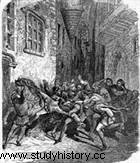 Duke John the Fearless had a string of successes in the years following the murder of his rival:in 1408, he defeated the Liégeois in Othée; in 1409, he seized power in Paris after making peace (of Chartres) with the children of the Duke of Orléans. But the following year, the other Greats ganged up against him, on the initiative of Jean de Berry. Two parties are then formed:the Burgundians, and the Armagnacs (the princes of Berry, Bourbon, Anjou, but also the queen and the Dauphin). It is civil war, interspersed with truces that are never really respected. The Duke of Burgundy had to abandon Paris in 1413, but it was above all the English who took advantage of the situation:they landed and crushed the French at Agincourt in 1415. Having taken over Paris in 1418, Jean sans Peur tried to get closer to the Dauphin (the future Charles VII) to counter the English threat, but he was assassinated in turn on September 10, 1419. His son Philippe le Bon then chose the English camp. The war between Armagnacs and Burgundians, which is only just beginning, therefore has terrible consequences for France when the Hundred Years War resumes...
Duke John the Fearless had a string of successes in the years following the murder of his rival:in 1408, he defeated the Liégeois in Othée; in 1409, he seized power in Paris after making peace (of Chartres) with the children of the Duke of Orléans. But the following year, the other Greats ganged up against him, on the initiative of Jean de Berry. Two parties are then formed:the Burgundians, and the Armagnacs (the princes of Berry, Bourbon, Anjou, but also the queen and the Dauphin). It is civil war, interspersed with truces that are never really respected. The Duke of Burgundy had to abandon Paris in 1413, but it was above all the English who took advantage of the situation:they landed and crushed the French at Agincourt in 1415. Having taken over Paris in 1418, Jean sans Peur tried to get closer to the Dauphin (the future Charles VII) to counter the English threat, but he was assassinated in turn on September 10, 1419. His son Philippe le Bon then chose the English camp. The war between Armagnacs and Burgundians, which is only just beginning, therefore has terrible consequences for France when the Hundred Years War resumes...
The assassination of the Duke of Burgundy Jean sans Peur on September 10, 1419 sparked the civil war in France, between Armagnacs and Burgundians . Four years earlier, King Henry V of England landed and inflicted a severe defeat on the French at the Battle of Agincourt. The conflict that tore the kingdom apart came at a bad time, while the Hundred Years War resumed in the worst possible way. Its roots are deep, and its consequences decisive.
Armagnacs and Burgundians, two opposing parties
The civil war that really breaks out with the assassination of John the Fearless has ancient ramifications.
Since Philip the Bold (not to be confused with the king of the same name) and the latter's marriage to Margaret of Flanders, the Duchy of Burgundy has been enlarged from Flanders, from Artois, Franche-Comté and the county of Nevers, then Charolais in 1390; all these territories having been united under the authority of Jean sans Peur at the death of his mother. The latter then conquered other regions, such as Auxerrois or “the Cities of the Somme” (Amiens, Corbie, Doullens, Saint-Quentin). In addition, the duchy exercises influence over nearby territories, such as Hainaut, the county of Holland or the duchy of Brabant. On the other hand, the Burgundian territory is not homogeneous, and the action of Louis d'Orléans threatening to definitively separate the two main parts of the duchy explains in part the decision of Jean sans Peur.
The rivalry between Armagnacs and Burgundians is also to be found in the influences on certain aristocratic clienteles. If the Burgundians are rather close to the nobles of the North and the merchant bourgeoisie, the Armagnacs are close to the nobles of the Center and the South and financial circles. Here again, the Duke of Orléans tried to establish relations in the heart of the Burgundian areas of influence, or those they were targeting, as in the Empire. This division and this competition between clienteles can be seen even in the entourage of King Charles VI, the supporters of the Burgundians being distinguished by certain symbols (cross of Saint Andrew, plane, etc.), the Armagnacs by others (a gnarled stick with motto "I bore him").
To this must be added the influence on public opinion, also divided, and which chooses the camp of one or the other, like Paris which takes an oath to Jean without fear. "Bourguignon" or "Armagnac" become insults, appears a propaganda made of rumors and accusations of witchcraft.
The opposition is also political and even religious. The Burgundians do not support the Pope of Avignon, unlike the Armagnacs. But it is especially against the English that the greatest differences are seen:the Duke of Burgundy, because of his strategic position in Flanders, prefers to negotiate with them, while the Duke of Orleans is much more offensive against them. Finally, their conception of the State differs, each defended by theoreticians (Christine de Pizan for example, for the Armagnacs):if for the Burgundians the model is rather to be found on the side of Saint Louis, certainly idealized, the Armagnacs develop a less popular program, with significant taxation and radical justice; it is the strong State, inspired by the experience of the Marmosets, and a stronger royal power in the face of feudalism. The armagnac party is therefore that of the king.
The Cabochian episode
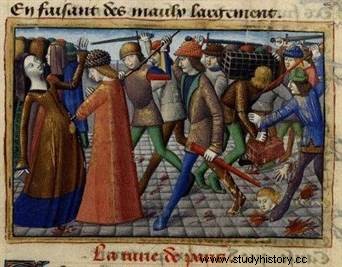 This rivalry between Armagnacs and Burgundians provoked a number of armed conflicts, as did struggles for influence at the court of the poor Charles VI and revolts in the main cities, Paris in the lead.
This rivalry between Armagnacs and Burgundians provoked a number of armed conflicts, as did struggles for influence at the court of the poor Charles VI and revolts in the main cities, Paris in the lead.
On this last point, we must cite the example of the "Cabochian episode":in 1413, at the insistence of John the Fearless, the king met in Paris the Estates General of Languedoïl. The city is under tension, but in favor of the Burgundians, and "militias" led by a butcher, Caboche, roam the streets and threaten a general revolt. It was in this atmosphere that a reform ordinance, with a strong Burgundian influence and called "Cabochienne", was promulgated at the end of May 1413. This did not, however, calm the revolt:the Burgundians were overwhelmed, and some of the supporters of the reform, especially among academics, switch to Armagnacs. The Cabochian movement is a failure and its main leaders beheaded; the Burgundians must leave Paris for a while.
This "Cabochian episode" is symptomatic of the struggles between the two parties while John the Fearless is still alive. Does his assassination change things?
Philip the Good succeeds John the Fearless
It is in this context that the interview of Montereau takes place in 1419, during which Jean sans Peur is killed under suspicious conditions, in the presence of the Dauphin. The Duke of Burgundy is assassinated at the very moment when, worrying about the English danger, he was trying to get closer to the Dauphin. This has the consequence of throwing Burgundy into the enemy camp of France.
Jean sans Peur's son, Philippe, succeeds him. He was born in Dijon in 1396 and is the only son of the Duke and Margaret of Bavaria. Count of Charolais, he began his political action from 1411, then fought with his father in Flanders in 1414. Philippe was in Flanders when his father was assassinated in Montereau. He then became Duke of Burgundy and continued the policy of Jean, while allying himself with the English. France then saw its civil war enter a new phase, much more dangerous because of the English presence following Agincourt. English people determined to play divisions to recover the crown of France.
The Treaty of Troyes (May 21, 1420)
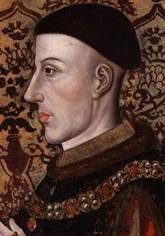
The English influence, taking advantage of the divisions between Burgundians and Armagnacs and the madness of Charles VI, has already manifested itself since the years 1413-1415 and the advent of Henri V. The assassination of Jean sans Peur and the “rallying” of Philippe le Bon accelerate things. The King of England is in a strong position, able to impose his demands, including on his new Burgundian allies. From March 1420, Philip the Good and Isabeau of Bavaria worked on a treaty, and they were joined in May by Henry V, who ostensibly displayed his satisfaction. On May 21, the Treaty of Troyes stipulates that Charles VI makes Henry V his heir to the crown of France, by marrying him to his daughter Catherine de Valois; the Dauphin Charles is stripped of all his rights. On the death of Charles VI, it is therefore Henry V, King of England, who will be King of France...
The resistance of the Armagnacs
Obviously the dolphin party does not accept this treaty. The English and their Burgundian allies tried to enforce it during the years 1420-1422. The Armagnacs, with the dauphin taking refuge in Bourges, control a good part of the French territory and have significant resources; Henri V must therefore activate, even if he has been recognized as legitimate as far as Paris. He took Montereau (where Jean sans Peur was murdered) in June 1420, then besieged Melun for several months (it capitulated in November).
His attitude began to annoy even his Burgundian allies, and it became almost impossible for him to apply the Treaty of Troyes. Moreover, even within its French lands, in Normandy for example, one criticizes its way of carrying out the war, and especially its taxes to do it. Henry V did not change his policy and method, however, and laid siege to Meaux in May 1422...
The death of kings, and the end of the civil war
It was during the siege of Meaux that the King of England contracted dysentery. The city capitulates, but Henry V is physically weakened. The coming summer, scorching, ends up finishing him:he dies at the Château de Vincennes on August 31. His nine-month-old son, Henry VI, is proclaimed King of England, not yet King of France. The situation is a little more complicated when, on October 21, 1422, King Charles VI also dies. Philip the Good then thinks, as an ally, to be able to pose as regent; but in the face of English pressure, it was the Duke of Bedford who assumed this charge, while little Henry VI was proclaimed King of France. A few days later, Charles VII in turn had himself proclaimed King of France:the Hundred Years War resumed with renewed vigor.
The following years are undecided:the English try to keep the Duke of Burgundy as an ally; for this, the Duke of Bedford marries the sister of Philippe le Bon, then with him approaches Jean V of Brittany, at the Treaty of Amiens (1423). The Duke of Burgundy actually wants to take advantage of his alliance with England to expand his possessions in the North, such as Hainaut or the County of Namur. But he came up against his allies in these regions, and crises multiplied between the English and the Burgundians until the early 1430s. The alliance fizzled out...
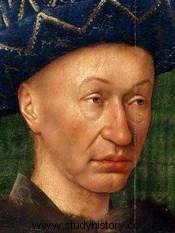 Indeed, at the same time, Charles VII consolidated his positions, despite indecisive and difficult first years, marked by a war of attrition. In May 1429, Joan of Arc liberated Orléans from the siege that the English had subjected her to since the previous year:it was a turning point, followed by the coronation of Charles VII in Reims.
Indeed, at the same time, Charles VII consolidated his positions, despite indecisive and difficult first years, marked by a war of attrition. In May 1429, Joan of Arc liberated Orléans from the siege that the English had subjected her to since the previous year:it was a turning point, followed by the coronation of Charles VII in Reims.
The war continued but, on the Burgundian side, a "peace party" developed around Nicolas Rolin, chancellor of Philippe le Bon. The rapprochement with the party of Charles VII can then begin, the Treaty of Troyes is even considered null and void. This led to the signing of the Treaty of Arras on September 20, 1435. The conditions of this peace are subject to debate (was Philippe le Bon duped?), but the consequences are clear:civil war between Armagnacs and Burgundians is over. Charles VII can continue to fight the English, while the Duke of Burgundy turns to the North. However, the situation remained confused for many years, at least until the victory against the English in 1453.
And the distrust between the King of France and Burgundy will resume even more with the fight between Louis XI and Charles the Bold, both turbulent sons of Charles VII and Philippe the Good…
Non-exhaustive bibliography
- G. Minois, The Hundred Years War, Tempus, 2010.
- J. Favier, The Hundred Years War, Fayard, 2005.
- C. Gauvard, France in the Middle Ages from the 5th to the 15th century, PUF, 2005.
- B. Schnerb, Armagnacs and Burgundians. The Cursed War, Perrin, 1988.
